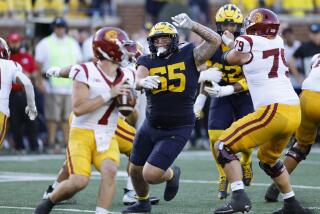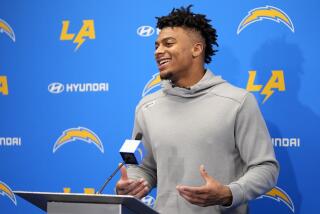SMU Returns and Is Routed by Rice : In Mustangs’ First Game Since Nov. 22, 1986, Owls Get a Rare Victory, 35-6
- Share via
DALLAS — In front of 23,227 witnesses Saturday night in Ownby Stadium, SMU football rose from the death penalty.
Reporters flew in from across the country to describe it.
Bands played.
Fans rejoiced.
It was not, however, as joyous a moment as it might have been.
Mostly a collection of exuberant freshmen--only seven of the 89 players who suited up for the Mustangs had any previous college football experience--SMU was overwhelmed and overpowered by Rice, which takes some doing.
An eased-up 35-6 victory by the Owls was their first win in almost two years and ended an 18-game losing streak. Rice, which hasn’t had a winning season since 1963, had not beaten a Division I-A opponent since Nov. 29, 1986.
It had been even longer since SMU had fielded a team.
For that reason, the matchup generated tremendous interest.
The crowd in the renovated stadium, which saluted the Mustangs with a standing ovation as they took the field, fell just short of a sellout, and SMU officials issued more than 250 media credentials.
The curious had flocked to Texas for the resurrection of a football program that had been deemed so corrupt it was shut down in February 1987, when the National Collegiate Athletic Assn. announced that it had uncovered major rules violations for the second time in five years. The Mustangs were stripped of their 1987 schedule and, limited to a seven-game all-road schedule in 1988, elected to sit out last year, too.
The Mustangs hadn’t played a game since Nov. 22, 1986.
Between that date and Saturday night’s coming-out party, SMU made several changes in the way it conducts its football business.
University President A. Kenneth Pye was brought in from Duke and made it known that, in the future, SMU would strive to align itself more closely with the Ivy League, or something close to it, than with the Southwestern Conference. All but two of the latter’s nine schools have had their football programs sanctioned by the NCAA in the last 10 years.
No longer does SMU accept athletes that do not meet the school’s general admission standards, including a minimum score of 900 on the Scholastic Aptitude Test, which is 200 points higher than the NCAA standard.
And, of course, no longer will it pay its players, a practice that was revealed by the NCAA in its investigation of the program, circa 1986.
At least, that’s the idea.
In an effort to further de-emphasize the importance of the football program, the Mustangs have forsaken 65,024-seat Texas Stadium, home of the Dallas Cowboys, to play their home games in an on-campus facility that accommodates only 23,733 fans and hadn’t been used for SMU games since 1948.
Not that those who play in it will notice any difference.
Coach Forrest Gregg inherited a program short on scholarships and almost completely devoid of upperclassmen. His starting lineup against Rice included 15 freshmen, two sophomores and three seniors. Of the 89 players on the roster, only 41 are on scholarship and just 16 are not freshmen.
Mitchell Glieber, a senior wide receiver who caught three passes against Rice, is the only scholarship player remaining from the 1986 team.
Rice, 0-11 last season, walked into this golden opportunity as a 16-point favorite, which said a lot about the state of the SMU program.
Rice hadn’t been favored against an opponent since 1979.
Gregg’s young players, though, couldn’t have cared less.
“A lot of them were big-eyed out there,” Gregg said.
And why not?
Most of them had never experienced anything like it.
“It was well worth the wait,” said Glieber, who caught only two passes in the 1986 season.
Gathered last year, when 18 scholarship players and 42 walk-ons practiced in the Dallas heat four days a week and scrimmaged on Fridays, Gregg’s team had met daily under a sign that read: “SMU vs. Rice, Sept. 2, 1989.”
Were they excited?
Matt Lomenick, a junior from Miami, fairly leaped out of his uniform after kicking a 23-yard field goal to give the Mustangs a 3-0 lead less than three minutes into the game. SMU’s Cary Brabham had recovered the opening kickoff at the 16-yard line after Trevor Cobb of Rice had fumbled it away.
But that was about the extent of the Mustang highlights.
Shane Hollas of Rice, a converted free safety, looked as if he should have been a quarterback all along, completing 16 of 32 passes for 222 yards and two touchdowns, and running for 82 yards and two more touchdowns.
Rice piled up 506 total yards, averaging more than six yards a play, and limited SMU runners to 32 yards in 31 carries.
SMU hadn’t scored so few points against Rice since 1964, when it was beaten, 7-6, and hadn’t lost to the Owls since 1976.
More to Read
Go beyond the scoreboard
Get the latest on L.A.'s teams in the daily Sports Report newsletter.
You may occasionally receive promotional content from the Los Angeles Times.






